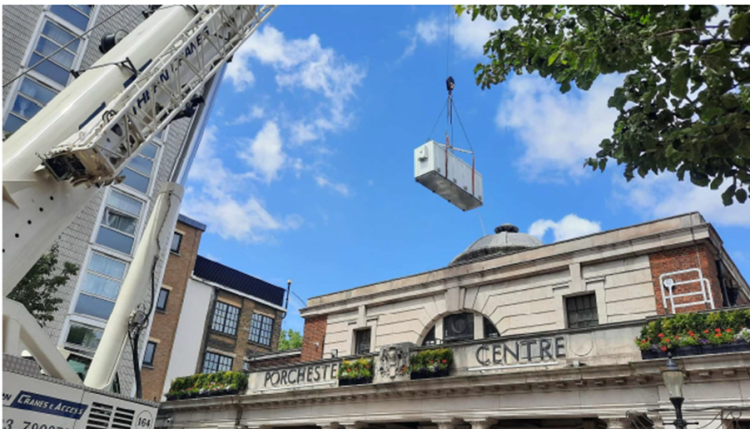Ambitious council makes giant steps to slash carbon emissions thanks to £13m government funding
Westminster City Council has slashed carbon emissions by almost 20%
Hard work, ambition and vision has paid off for a major London council which has slashed carbon emissions by almost 20% across its corporate property operational estate.
The initial phase of the council’s Carbon Management Programme at Westminster City Council has seen a reduction of almost 20%, with ongoing phases predicted to achieve an overall reduction of 30% in only five years.
Targeting council buildings is just one of the many measures being taken to reduce the carbon emissions across the borough.
The city is responsible for producing some of the greatest carbon emissions across the UK with some of the worst air pollution.
The council has been able to tap into the Public Sector Decarbonisation Scheme to help it meet its ambitious targets. It has set a target of becoming carbon neutral by 2030, part of Westminster’s overall commitment to become carbon neutral by 2040.
Council teams have been able to shake up the energy efficiency of several sites, including Paddington Library, the Queen Mother Sport Centre and Charing Cross Library as part of its plans. This has meant getting rid of old inefficient fossil fuel boilers.
These tailored solutions have helped us modernise our buildings, reduce emissions, and create better environments for our staff and communities.
Cabinet Member for Finance and Council Reform, Cllr David Boothroyd, said: “Our Carbon Management Programme has involved a huge amount of work across a diverse and active estate, from libraries and leisure centres to offices and schools.
“Every building presented its own challenges, and our delivery teams worked closely with staff and site personnel to minimise disruption while maintaining the highest standards of health and safety.
“Operating in central London means we’re often limited by space, so we’ve had to be innovative, for example, installing rooftop solar panels where ground-mounted systems simply aren’t feasible.
“These tailored solutions have helped us modernise our buildings, reduce emissions, and create better environments for our staff and communities.
“With buildings accounting for 86% of Westminster’s emissions, we’re determined to lead by example and tackle the climate emergency head-on.
“Thanks to the Public Sector Decarbonisation Scheme, we’ve made significant progress, and we’re now focused on the next phase of delivery to meet our 2030 carbon neutral target.”

Porchester Leisure Centre, Queensway.
Photo credit: Westminster City Council
Public Sector Decarbonisation Scheme
The Public Sector Decarbonisation Scheme, launched in 2020, is run by the Department for Energy Security and Net Zero and delivered by our teams at Salix.
In the recent government Spending Review, it was announced that whilst more than £1 billion of Public Sector Decarbonisation budget will still be invested between now and 2028 via existing Public Sector Decarbonisation Scheme grants and the Integrated Settlements with Greater Manchester and West Midlands Mayoral Combined Authorities, there will be no further investment in the Public Sector Decarbonisation Scheme at this time.
As part of Westminster City Council’s vision to become a carbon neutral local authority by 2030, it has made working towards a fairer environment, one of its five key ambitions as part of the ‘Fairer Westminster’ Strategy.
The Public Sector Decarbonisation Scheme has helped to contribute towards this aim and in 2021 Westminster City Council was awarded £13 million under the fund.
The first phase of the Carbon Management Programme was delivered through the Retrofit Accelerator Framework, which saw a total of 135 separate initiatives implemented across 61 buildings.
Feasibility studies were carried out across the portfolio to determine which blend of energy conservation measures could be put into action.
The energy efficiency works included upgrades to lighting, ventilation and building management systems within council buildings. In addition to this, the programme included harnessing the latest renewable technologies, such as solar PV and air source heat pumps.
What was achieved with Westminster City Council?
- 1,700kW air source heat pumps installed across 10 sites
- Enhanced insulation installed across 26 sites
- 660kWp rooftop solar
- 6,500 LED replacements installed across 23 sites
Overall, the project will achieve a yearly reduction of 1,600 tonnes of CO2 emissions.
It’s a complex mission to reduce carbon emissions in an area serving around 211,500 people.
The challenge was increased because most of the buildings included as part of the programme were actively in use. These included leisure centres, schools, offices, libraries and health centres.
Projects also involved the management of road closures across Westminster’s busy network and obtaining planning approvals due to the historic nature of many of the buildings in the borough.
The planning involved in decarbonising a city are great, cost requirements, logistics, working around existing infrastructure and more.
At Salix, we’re proud to have worked with Westminster City Council to help shake up the way it uses its energy.
It’s clear that the teams have used innovation, drive and ambition to set the standards creating better buildings in which local people can enjoy, work and thrive.
They have modernised many sites and set them up for a cleaner future, although the work must go on.
Thank you to Westminster City Council for supporting our work.




